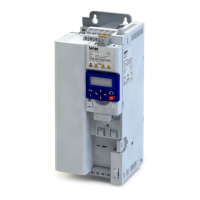10.2 Sensorless control for synchronous motor (SL-PSM)
The sensorless control for synchronous motors is based on a decoupled, separated control of
the torque-producing current and the current in eld direcon. In contrast to the servo con-
trol, the actual speed value and rotor posion are reconstructed via a motor model.
NOTICE
In case of this motor control type, an adjustable, constant current is injected in the lower
speed range. If this current is higher than the rated motor current, the motor may heat up in
the lower speed range. This eect increases if the motor is operated in the lower speed range
for a longer period of me.
Possible consequence: Destrucon of the motor by overheang
▶
Do not operate the motor for a longer period of me in the lower speed range.
▶
For detecng and monitoring the motor temperature, we recommend a temperature feed-
back via PTC thermistor or thermal contact. 4Motor temperature monitoring ^ 234
Precondions
The sensorless control for synchronous motors (SL-PSM) is possible up to a rated power of
maximally 22 kW.
Details
Pole posion idencaon (PLI)
•
For controlling a permanent-magnet synchronous motor, the pole posion - the angle
between the motor phase U and the eld axis of the rotor - must be known.
•
If the drive is at a standsll, the "pole posion idencaon (PLI)" funcon is immediately
acvated aer the inverter is enabled. 4Synchronous motor: Pole posion idencaon
(PPI) ^ 167
Conguring the motor control
Sensorless control for synchronous motor (SL-PSM)
170

